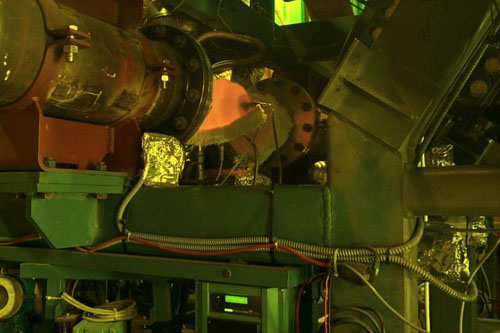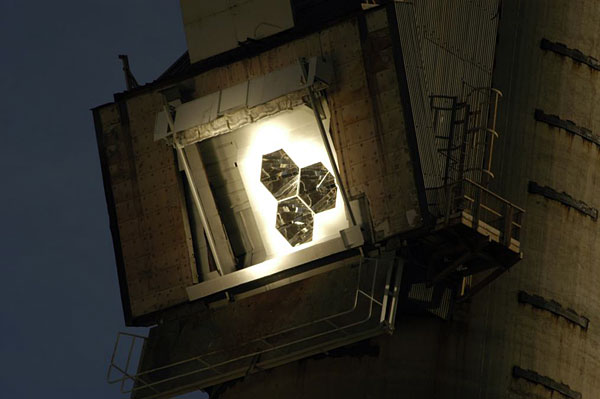

POINT-FOCUS CONCENTRATING SOLAR THERMAL TECHNOLOGIES
SolHyCo (SOLar HYbrid power and COgeneration plants)
Participants: DLR (D, coordinator), TURBEC (IT), CIEMAT (ES), CEA (FR), Ormat (IL), Abengoa (ES), FTF (DE), Sonatrach (DZ), GEA (PL), Vitalux (BR), and the IIE (MX)
Contact: Peter Heller (peter.heller@dlr.de); Thörsten Denk (thorsten.denk@psa.es)
Funding: European Commission 6th Framework Program (Contract 019830)
Duration: January 1, 2006 to June 30, 2014
Background: This project is the heir to the successful REFOS, Solgate and HST projects that developed pressurized receiver solutions for integrating solar heat in gas cycles or combined cycles and demonstrated their capacity to produce electricity in hybrid schemes (with conventional fuel backup) in a 250 kWe system. This type of solar-hybrid system combines solar energy and fossil fuels, but they are only 100% sustainable if they use biofuels.
Purpose: The main purpose of SolHyCo is to develop a very high-efficiency solar-hybrid microturbine for generation of both electricity and heat, working with concentrated solar radiation and biofuels, and making it a completely renewable system. Another purpose of the project is study of market introduction in sunny countries, in particular, Algeria, Brazil and Mexico.
At the Plataforma Solar, solar testing will be done in two stages in the CESA-1 Tower. The first will be in 2008 with the 250‑kW turbine from the Israeli Ormat company on the 60‑m level (Figure 3.15), which was already operated very successfully in the SOLGATE Project. This turbine will be fed by three pressurized air receivers (one tube receiver and two volumetric) with a total thermal power of 1 MW. The kerosene used in Solgate has been replaced by a 100% biological diesel fuel (biodiesel).

The second stage will be in the same place in 2009 with a Italian/Swiss Turbec turbine which has an electrical power of 100 kW. A new type of pressurized air receiver is being developed for this turbine based on the tube concept, but with high-technology “multilayer pipes”. These pipes have three layers, the outer one of high-temperature steel, the middle one copper for better heat distribution around the circumference of the pipe, and the inner one steel again, but very thin, for mechanical stabilization of the copper layer.
Achievements in 2007: In 2007, the turbine and the receivers were prepared for solar testing. Because of the long time it had been without operating, many defects were found in the system which delayed startup considerably. After the manufacturer had checked over the metering valve and made the modifications necessary for use with biodiesel, the turbine was finally started up. With the turbine running, vibration measurements were made to diagnose any imbalance. The results were within tolerance.
Afterwards, the receiver system could be checked over. Both quartz windows were disassembled for thorough cleaning of the crystal, some mirrors were repaired, and the secondary concentrator water-cooling system, which was rather badly damaged, was repaired and improved with an automatic water circuit filling system, which replaces amounts lost.
The last job was to install another tank for startup which runs on kerosene. In principle there are no basic problems for starting up with biodiesel, but it would require, on one hand, an in-depth revision of the turbine control system and on the other, modification of several fuel feed system components to resist the more aggressive atmosphere of biodiesel for at least one year. The new system (Figure 3.16) includes a second line, that goes from a new little 40‑m tank about 10 m above the turbine to the receiver room where a remotely controlled three-way valve supplies one fuel or the other. The strategy is to start up with kerosene, wait connection to the grid, and then change over as quickly as possible to biodiesel and begin with solar energy. When the turbine is shut down, the procedure is reversed, but with the additional need to leave the system running on kerosene for about 15 minutes to ensure that the volume between the three-way valve and the combustion chamber has completely filled with kerosene. This procedure consumes about 25 liters of kerosene. Apart from this, two remotely controlled valves were also installed so the operator could cut off the fuel flow in case of emergency. There were only two manual valves for this before.

Solar testing finally began in March 2008 and is scheduled to finish at the end of September. The main goals are calibration of the air mass flow measured with two new measurement systems and accumulation of around 100 solar test hours to gather as much system durability information as possible.